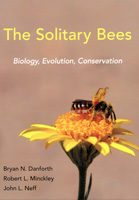While social bees such as honey bees and bumble bees are familiar to most people, they comprise less than 10 percent of all bee species in the world. The vast majority of bees lead solitary lives, surviving without the help of a hive and using their own resources to fend off danger and protect their offspring. This book draws on new research to provide a comprehensive and authoritative overview of solitary bee biology, offering an unparalleled look at these remarkable insects.
The Solitary Bees uses a modern phylogenetic framework to shed new light on the life histories and evolution of solitary bees. It explains the foraging behaviour of solitary bees, their development, and competitive mating tactics. The book describes how they construct complex nests using an amazing variety of substrates and materials, and how solitary bees have co-opted beneficial mites, nematodes, and fungi to provide safe environments for their brood. It looks at how they have evolved intimate partnerships with flowering plants and examines their associations with predators, parasites, microbes, and other bees. This up-to-date synthesis of solitary bee biology is an essential resource for students and researchers. one that paves the way for future scholarship on the subject.
Beautifully illustrated throughout, The Solitary Bees also documents the critical role solitary bees play as crop pollinators, and raises awareness of the dire threats they face, from habitat loss and climate change to pesticides, pathogens. parasites. and invasive species.
The Authors
– Bryan N. Danforth is professor of entomology at Cornell University. – Robert L. Minckley is senior lecturer in biology at the University of Rochester. – John L. Neff is director of the Central Texas Melittological Institute.
“The Solitary Bees is the essential guide to the biology, phylogeny, and behaviour of these unsung heroes of the bee world. It skillfully blends the most up-to-date scientific knowledge with natural history studies to provide stunning insights into this fascinating group.”
Simon Potts, University of Reading
“A significant contribution by respected leaders in this important field of research. This is the first book to synthesise what we know about the evolution, lifestyles, and associates of solitary bees.”
Robbin W. Thorp, coauthor of California Sees and Blooms: A Guide for Gardeners and Naturalists
“This richly detailed yet accessible book covers the ecology, evolution, and life history of solitary bees. A must-read for seasoned researchers as well as those who are new to the field.”
Neal M. Williams, University of California, Davis



